Evidence-Based Practice: Physical Activity in Treating Depression
VerifiedAdded on 2023/06/05
|12
|2770
|91
Literature Review
AI Summary
This literature review investigates the effectiveness of physical activity interventions compared to medication in reducing depression in women within two months. It references studies, including a randomized control trial by Pereira et al. (2013), which demonstrated the benefits of aerobic and muscle strength exercises for neurological health and depression reduction in elderly women. The review further analyzes research comparing medication to physical activity in pregnant women and middle-aged women, consistently finding that physical activity plays a significant role in improving mental health and reducing depression symptoms. Future research is recommended to determine the optimal types and intensity of exercise for depression interventions, considering individual health conditions. This assignment provides a comprehensive overview of the evidence supporting physical activity as a viable intervention for depression, highlighting the need for further research to refine its application.
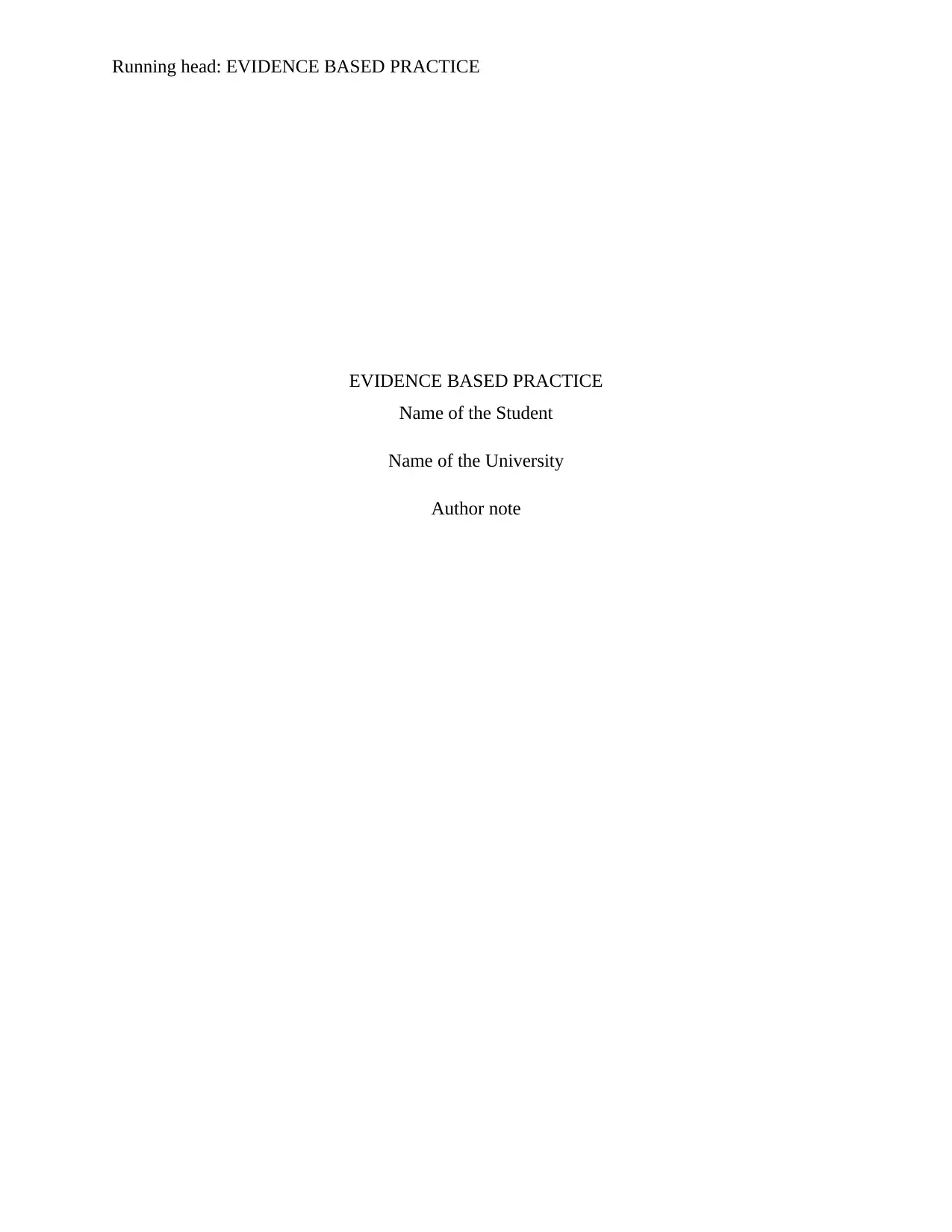
Running head: EVIDENCE BASED PRACTICE
EVIDENCE BASED PRACTICE
Name of the Student
Name of the University
Author note
EVIDENCE BASED PRACTICE
Name of the Student
Name of the University
Author note
Paraphrase This Document
Need a fresh take? Get an instant paraphrase of this document with our AI Paraphraser
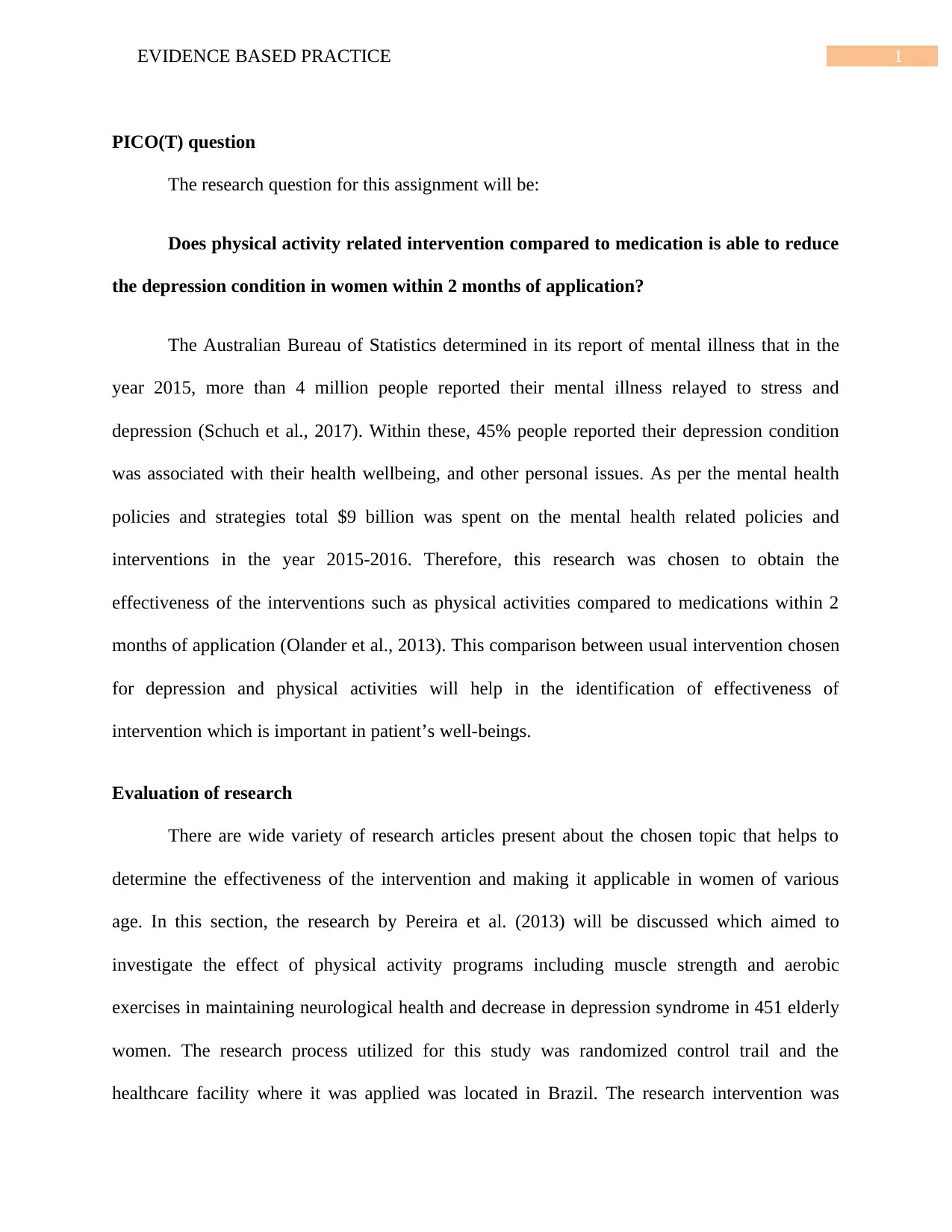
1EVIDENCE BASED PRACTICE
PICO(T) question
The research question for this assignment will be:
Does physical activity related intervention compared to medication is able to reduce
the depression condition in women within 2 months of application?
The Australian Bureau of Statistics determined in its report of mental illness that in the
year 2015, more than 4 million people reported their mental illness relayed to stress and
depression (Schuch et al., 2017). Within these, 45% people reported their depression condition
was associated with their health wellbeing, and other personal issues. As per the mental health
policies and strategies total $9 billion was spent on the mental health related policies and
interventions in the year 2015-2016. Therefore, this research was chosen to obtain the
effectiveness of the interventions such as physical activities compared to medications within 2
months of application (Olander et al., 2013). This comparison between usual intervention chosen
for depression and physical activities will help in the identification of effectiveness of
intervention which is important in patient’s well-beings.
Evaluation of research
There are wide variety of research articles present about the chosen topic that helps to
determine the effectiveness of the intervention and making it applicable in women of various
age. In this section, the research by Pereira et al. (2013) will be discussed which aimed to
investigate the effect of physical activity programs including muscle strength and aerobic
exercises in maintaining neurological health and decrease in depression syndrome in 451 elderly
women. The research process utilized for this study was randomized control trail and the
healthcare facility where it was applied was located in Brazil. The research intervention was
PICO(T) question
The research question for this assignment will be:
Does physical activity related intervention compared to medication is able to reduce
the depression condition in women within 2 months of application?
The Australian Bureau of Statistics determined in its report of mental illness that in the
year 2015, more than 4 million people reported their mental illness relayed to stress and
depression (Schuch et al., 2017). Within these, 45% people reported their depression condition
was associated with their health wellbeing, and other personal issues. As per the mental health
policies and strategies total $9 billion was spent on the mental health related policies and
interventions in the year 2015-2016. Therefore, this research was chosen to obtain the
effectiveness of the interventions such as physical activities compared to medications within 2
months of application (Olander et al., 2013). This comparison between usual intervention chosen
for depression and physical activities will help in the identification of effectiveness of
intervention which is important in patient’s well-beings.
Evaluation of research
There are wide variety of research articles present about the chosen topic that helps to
determine the effectiveness of the intervention and making it applicable in women of various
age. In this section, the research by Pereira et al. (2013) will be discussed which aimed to
investigate the effect of physical activity programs including muscle strength and aerobic
exercises in maintaining neurological health and decrease in depression syndrome in 451 elderly
women. The research process utilized for this study was randomized control trail and the
healthcare facility where it was applied was located in Brazil. The research intervention was
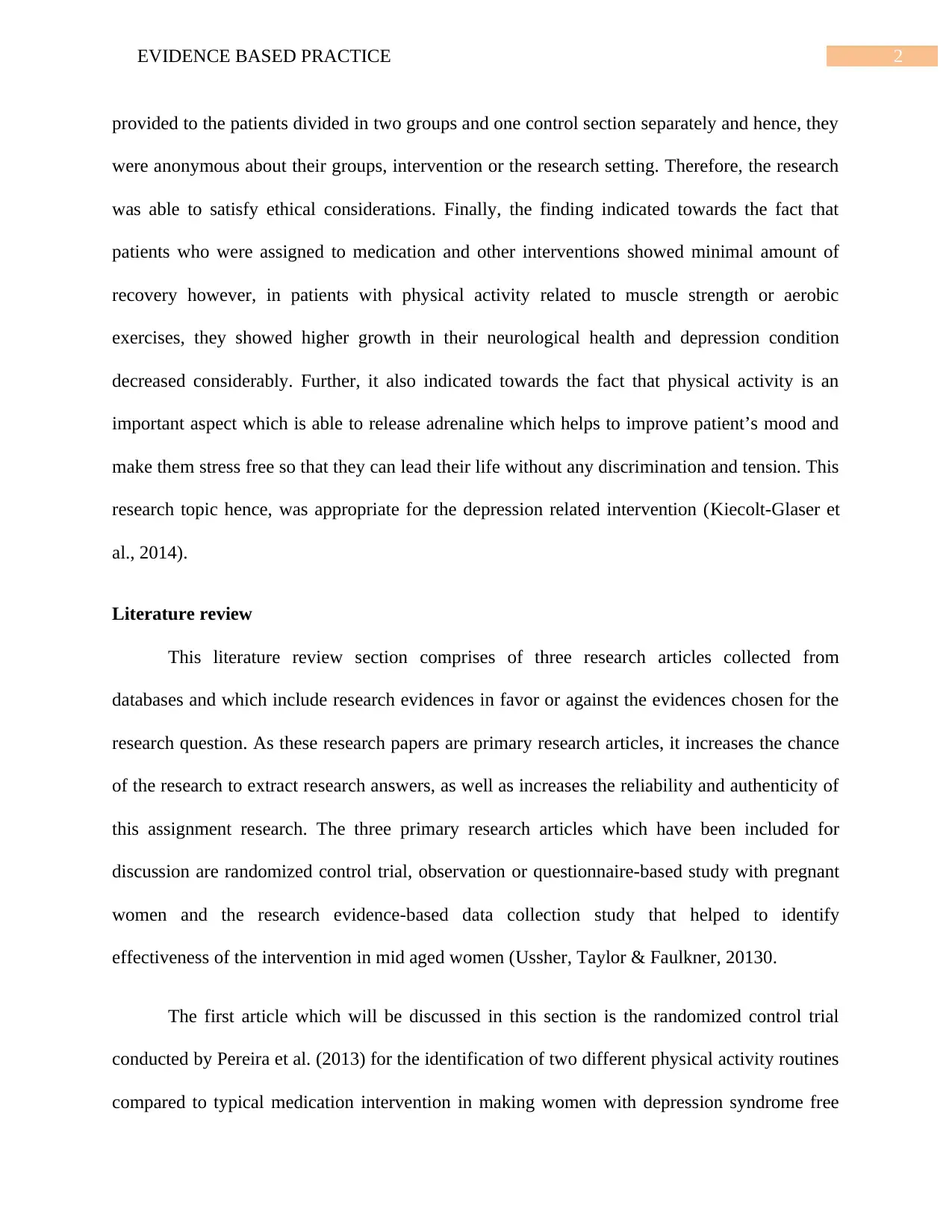
2EVIDENCE BASED PRACTICE
provided to the patients divided in two groups and one control section separately and hence, they
were anonymous about their groups, intervention or the research setting. Therefore, the research
was able to satisfy ethical considerations. Finally, the finding indicated towards the fact that
patients who were assigned to medication and other interventions showed minimal amount of
recovery however, in patients with physical activity related to muscle strength or aerobic
exercises, they showed higher growth in their neurological health and depression condition
decreased considerably. Further, it also indicated towards the fact that physical activity is an
important aspect which is able to release adrenaline which helps to improve patient’s mood and
make them stress free so that they can lead their life without any discrimination and tension. This
research topic hence, was appropriate for the depression related intervention (Kiecolt-Glaser et
al., 2014).
Literature review
This literature review section comprises of three research articles collected from
databases and which include research evidences in favor or against the evidences chosen for the
research question. As these research papers are primary research articles, it increases the chance
of the research to extract research answers, as well as increases the reliability and authenticity of
this assignment research. The three primary research articles which have been included for
discussion are randomized control trial, observation or questionnaire-based study with pregnant
women and the research evidence-based data collection study that helped to identify
effectiveness of the intervention in mid aged women (Ussher, Taylor & Faulkner, 20130.
The first article which will be discussed in this section is the randomized control trial
conducted by Pereira et al. (2013) for the identification of two different physical activity routines
compared to typical medication intervention in making women with depression syndrome free
provided to the patients divided in two groups and one control section separately and hence, they
were anonymous about their groups, intervention or the research setting. Therefore, the research
was able to satisfy ethical considerations. Finally, the finding indicated towards the fact that
patients who were assigned to medication and other interventions showed minimal amount of
recovery however, in patients with physical activity related to muscle strength or aerobic
exercises, they showed higher growth in their neurological health and depression condition
decreased considerably. Further, it also indicated towards the fact that physical activity is an
important aspect which is able to release adrenaline which helps to improve patient’s mood and
make them stress free so that they can lead their life without any discrimination and tension. This
research topic hence, was appropriate for the depression related intervention (Kiecolt-Glaser et
al., 2014).
Literature review
This literature review section comprises of three research articles collected from
databases and which include research evidences in favor or against the evidences chosen for the
research question. As these research papers are primary research articles, it increases the chance
of the research to extract research answers, as well as increases the reliability and authenticity of
this assignment research. The three primary research articles which have been included for
discussion are randomized control trial, observation or questionnaire-based study with pregnant
women and the research evidence-based data collection study that helped to identify
effectiveness of the intervention in mid aged women (Ussher, Taylor & Faulkner, 20130.
The first article which will be discussed in this section is the randomized control trial
conducted by Pereira et al. (2013) for the identification of two different physical activity routines
compared to typical medication intervention in making women with depression syndrome free
⊘ This is a preview!⊘
Do you want full access?
Subscribe today to unlock all pages.

Trusted by 1+ million students worldwide
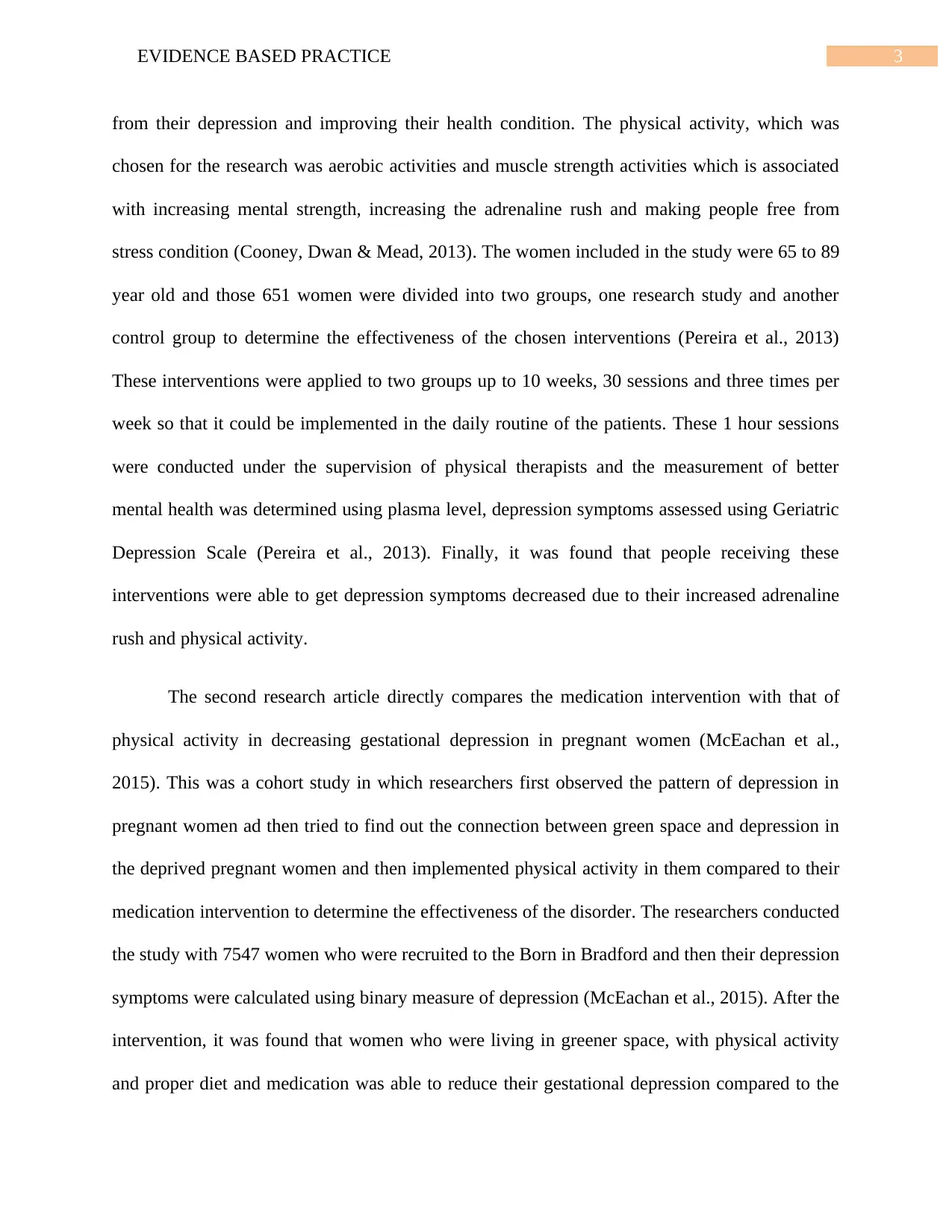
3EVIDENCE BASED PRACTICE
from their depression and improving their health condition. The physical activity, which was
chosen for the research was aerobic activities and muscle strength activities which is associated
with increasing mental strength, increasing the adrenaline rush and making people free from
stress condition (Cooney, Dwan & Mead, 2013). The women included in the study were 65 to 89
year old and those 651 women were divided into two groups, one research study and another
control group to determine the effectiveness of the chosen interventions (Pereira et al., 2013)
These interventions were applied to two groups up to 10 weeks, 30 sessions and three times per
week so that it could be implemented in the daily routine of the patients. These 1 hour sessions
were conducted under the supervision of physical therapists and the measurement of better
mental health was determined using plasma level, depression symptoms assessed using Geriatric
Depression Scale (Pereira et al., 2013). Finally, it was found that people receiving these
interventions were able to get depression symptoms decreased due to their increased adrenaline
rush and physical activity.
The second research article directly compares the medication intervention with that of
physical activity in decreasing gestational depression in pregnant women (McEachan et al.,
2015). This was a cohort study in which researchers first observed the pattern of depression in
pregnant women ad then tried to find out the connection between green space and depression in
the deprived pregnant women and then implemented physical activity in them compared to their
medication intervention to determine the effectiveness of the disorder. The researchers conducted
the study with 7547 women who were recruited to the Born in Bradford and then their depression
symptoms were calculated using binary measure of depression (McEachan et al., 2015). After the
intervention, it was found that women who were living in greener space, with physical activity
and proper diet and medication was able to reduce their gestational depression compared to the
from their depression and improving their health condition. The physical activity, which was
chosen for the research was aerobic activities and muscle strength activities which is associated
with increasing mental strength, increasing the adrenaline rush and making people free from
stress condition (Cooney, Dwan & Mead, 2013). The women included in the study were 65 to 89
year old and those 651 women were divided into two groups, one research study and another
control group to determine the effectiveness of the chosen interventions (Pereira et al., 2013)
These interventions were applied to two groups up to 10 weeks, 30 sessions and three times per
week so that it could be implemented in the daily routine of the patients. These 1 hour sessions
were conducted under the supervision of physical therapists and the measurement of better
mental health was determined using plasma level, depression symptoms assessed using Geriatric
Depression Scale (Pereira et al., 2013). Finally, it was found that people receiving these
interventions were able to get depression symptoms decreased due to their increased adrenaline
rush and physical activity.
The second research article directly compares the medication intervention with that of
physical activity in decreasing gestational depression in pregnant women (McEachan et al.,
2015). This was a cohort study in which researchers first observed the pattern of depression in
pregnant women ad then tried to find out the connection between green space and depression in
the deprived pregnant women and then implemented physical activity in them compared to their
medication intervention to determine the effectiveness of the disorder. The researchers conducted
the study with 7547 women who were recruited to the Born in Bradford and then their depression
symptoms were calculated using binary measure of depression (McEachan et al., 2015). After the
intervention, it was found that women who were living in greener space, with physical activity
and proper diet and medication was able to reduce their gestational depression compared to the
Paraphrase This Document
Need a fresh take? Get an instant paraphrase of this document with our AI Paraphraser
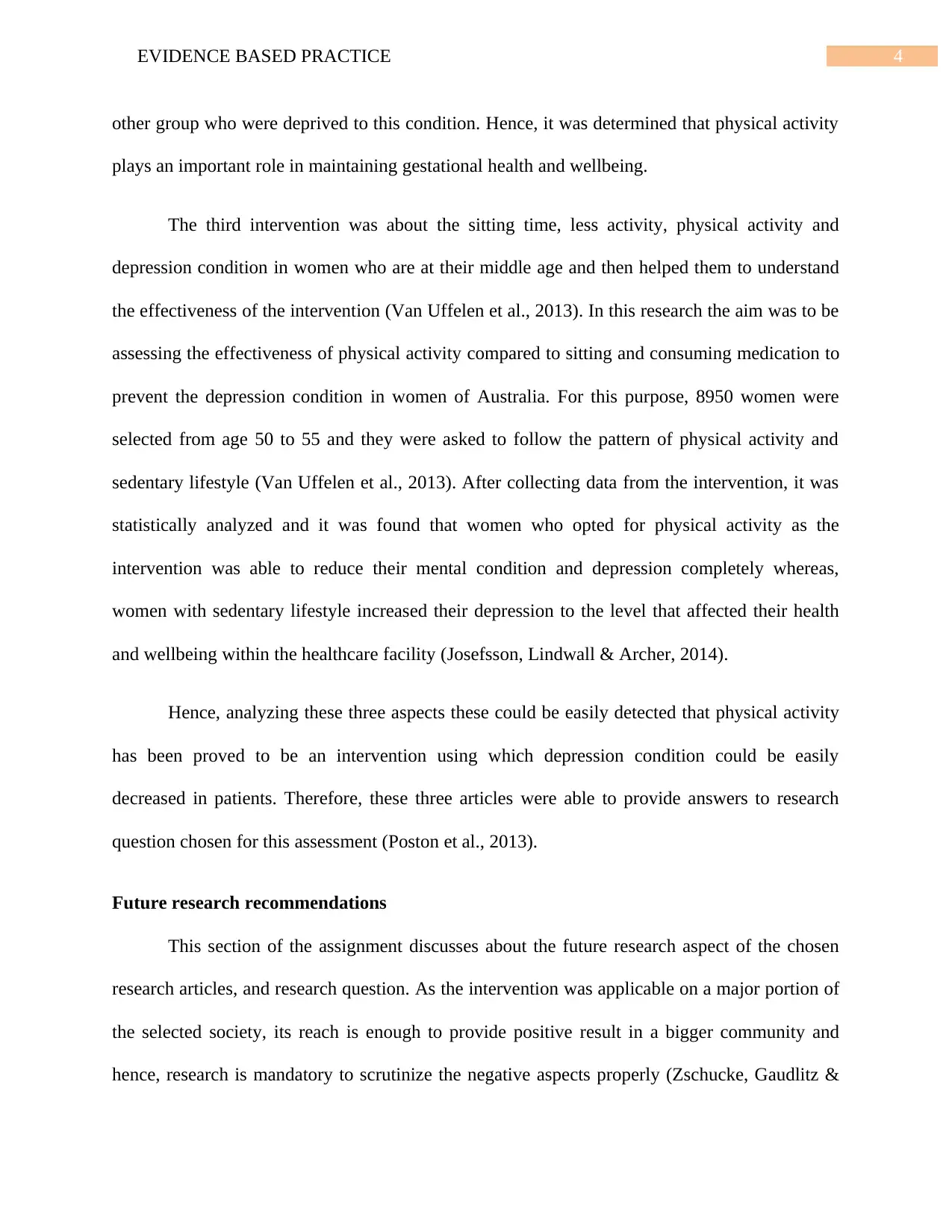
4EVIDENCE BASED PRACTICE
other group who were deprived to this condition. Hence, it was determined that physical activity
plays an important role in maintaining gestational health and wellbeing.
The third intervention was about the sitting time, less activity, physical activity and
depression condition in women who are at their middle age and then helped them to understand
the effectiveness of the intervention (Van Uffelen et al., 2013). In this research the aim was to be
assessing the effectiveness of physical activity compared to sitting and consuming medication to
prevent the depression condition in women of Australia. For this purpose, 8950 women were
selected from age 50 to 55 and they were asked to follow the pattern of physical activity and
sedentary lifestyle (Van Uffelen et al., 2013). After collecting data from the intervention, it was
statistically analyzed and it was found that women who opted for physical activity as the
intervention was able to reduce their mental condition and depression completely whereas,
women with sedentary lifestyle increased their depression to the level that affected their health
and wellbeing within the healthcare facility (Josefsson, Lindwall & Archer, 2014).
Hence, analyzing these three aspects these could be easily detected that physical activity
has been proved to be an intervention using which depression condition could be easily
decreased in patients. Therefore, these three articles were able to provide answers to research
question chosen for this assessment (Poston et al., 2013).
Future research recommendations
This section of the assignment discusses about the future research aspect of the chosen
research articles, and research question. As the intervention was applicable on a major portion of
the selected society, its reach is enough to provide positive result in a bigger community and
hence, research is mandatory to scrutinize the negative aspects properly (Zschucke, Gaudlitz &
other group who were deprived to this condition. Hence, it was determined that physical activity
plays an important role in maintaining gestational health and wellbeing.
The third intervention was about the sitting time, less activity, physical activity and
depression condition in women who are at their middle age and then helped them to understand
the effectiveness of the intervention (Van Uffelen et al., 2013). In this research the aim was to be
assessing the effectiveness of physical activity compared to sitting and consuming medication to
prevent the depression condition in women of Australia. For this purpose, 8950 women were
selected from age 50 to 55 and they were asked to follow the pattern of physical activity and
sedentary lifestyle (Van Uffelen et al., 2013). After collecting data from the intervention, it was
statistically analyzed and it was found that women who opted for physical activity as the
intervention was able to reduce their mental condition and depression completely whereas,
women with sedentary lifestyle increased their depression to the level that affected their health
and wellbeing within the healthcare facility (Josefsson, Lindwall & Archer, 2014).
Hence, analyzing these three aspects these could be easily detected that physical activity
has been proved to be an intervention using which depression condition could be easily
decreased in patients. Therefore, these three articles were able to provide answers to research
question chosen for this assessment (Poston et al., 2013).
Future research recommendations
This section of the assignment discusses about the future research aspect of the chosen
research articles, and research question. As the intervention was applicable on a major portion of
the selected society, its reach is enough to provide positive result in a bigger community and
hence, research is mandatory to scrutinize the negative aspects properly (Zschucke, Gaudlitz &
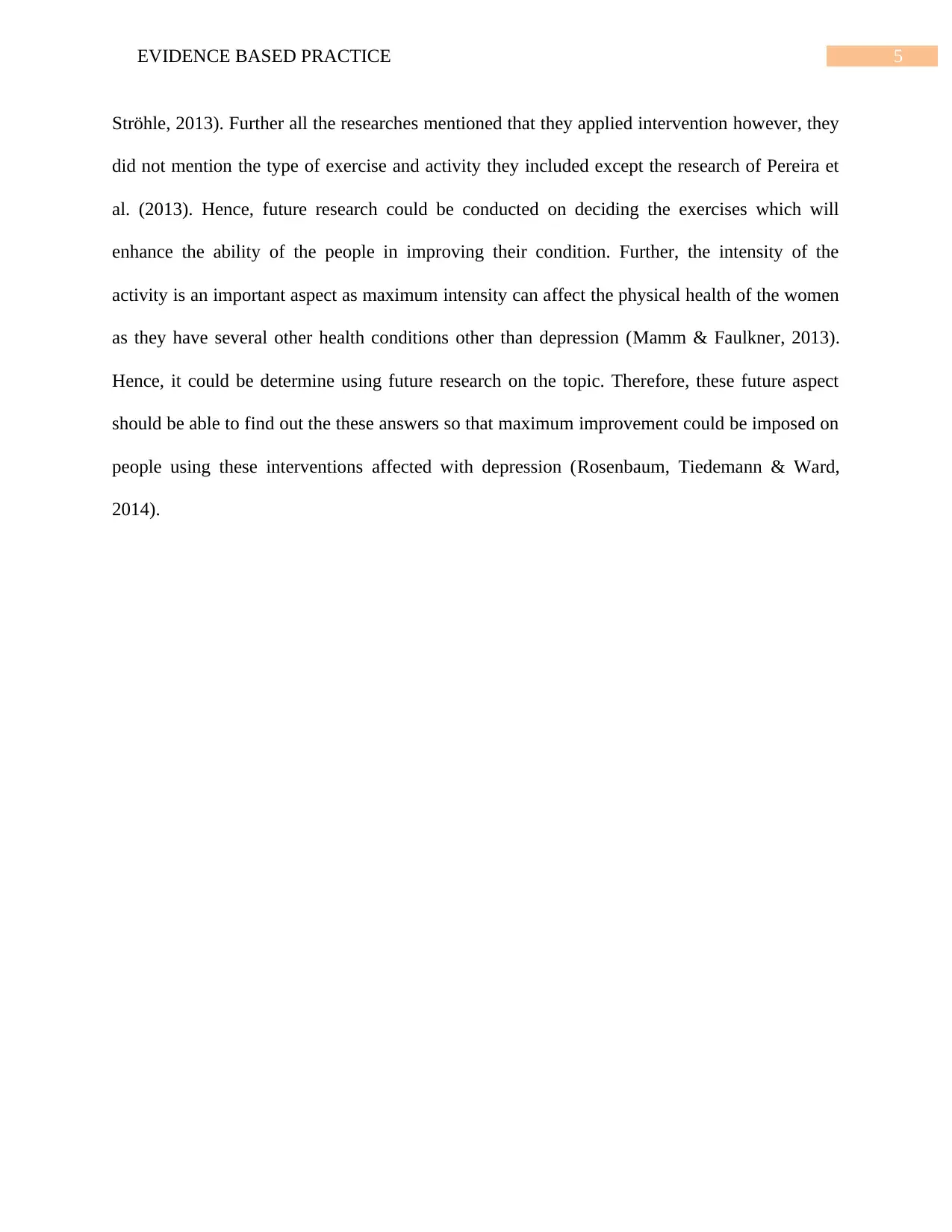
5EVIDENCE BASED PRACTICE
Ströhle, 2013). Further all the researches mentioned that they applied intervention however, they
did not mention the type of exercise and activity they included except the research of Pereira et
al. (2013). Hence, future research could be conducted on deciding the exercises which will
enhance the ability of the people in improving their condition. Further, the intensity of the
activity is an important aspect as maximum intensity can affect the physical health of the women
as they have several other health conditions other than depression (Mamm & Faulkner, 2013).
Hence, it could be determine using future research on the topic. Therefore, these future aspect
should be able to find out the these answers so that maximum improvement could be imposed on
people using these interventions affected with depression (Rosenbaum, Tiedemann & Ward,
2014).
Ströhle, 2013). Further all the researches mentioned that they applied intervention however, they
did not mention the type of exercise and activity they included except the research of Pereira et
al. (2013). Hence, future research could be conducted on deciding the exercises which will
enhance the ability of the people in improving their condition. Further, the intensity of the
activity is an important aspect as maximum intensity can affect the physical health of the women
as they have several other health conditions other than depression (Mamm & Faulkner, 2013).
Hence, it could be determine using future research on the topic. Therefore, these future aspect
should be able to find out the these answers so that maximum improvement could be imposed on
people using these interventions affected with depression (Rosenbaum, Tiedemann & Ward,
2014).
⊘ This is a preview!⊘
Do you want full access?
Subscribe today to unlock all pages.

Trusted by 1+ million students worldwide
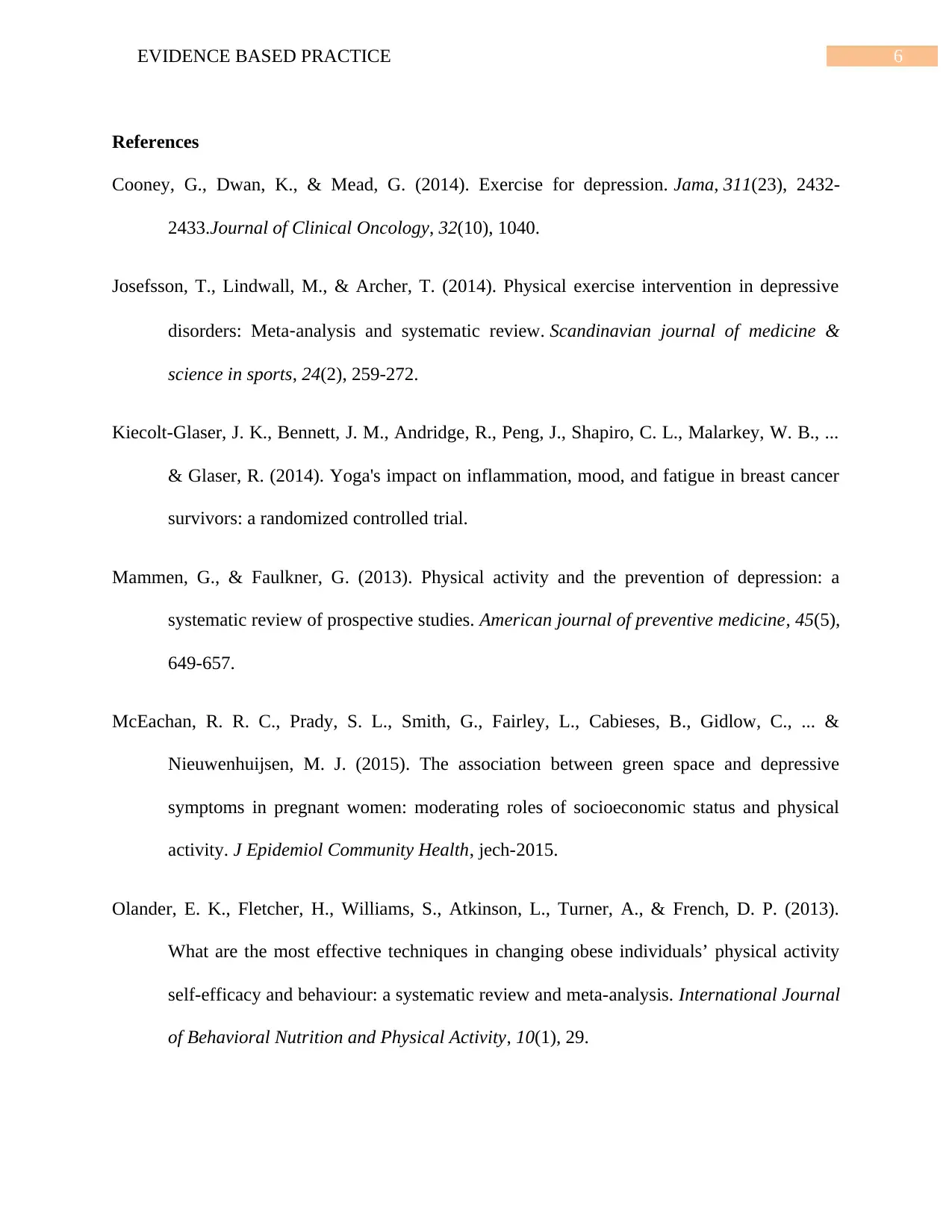
6EVIDENCE BASED PRACTICE
References
Cooney, G., Dwan, K., & Mead, G. (2014). Exercise for depression. Jama, 311(23), 2432-
2433.Journal of Clinical Oncology, 32(10), 1040.
Josefsson, T., Lindwall, M., & Archer, T. (2014). Physical exercise intervention in depressive
disorders: Meta‐analysis and systematic review. Scandinavian journal of medicine &
science in sports, 24(2), 259-272.
Kiecolt-Glaser, J. K., Bennett, J. M., Andridge, R., Peng, J., Shapiro, C. L., Malarkey, W. B., ...
& Glaser, R. (2014). Yoga's impact on inflammation, mood, and fatigue in breast cancer
survivors: a randomized controlled trial.
Mammen, G., & Faulkner, G. (2013). Physical activity and the prevention of depression: a
systematic review of prospective studies. American journal of preventive medicine, 45(5),
649-657.
McEachan, R. R. C., Prady, S. L., Smith, G., Fairley, L., Cabieses, B., Gidlow, C., ... &
Nieuwenhuijsen, M. J. (2015). The association between green space and depressive
symptoms in pregnant women: moderating roles of socioeconomic status and physical
activity. J Epidemiol Community Health, jech-2015.
Olander, E. K., Fletcher, H., Williams, S., Atkinson, L., Turner, A., & French, D. P. (2013).
What are the most effective techniques in changing obese individuals’ physical activity
self-efficacy and behaviour: a systematic review and meta-analysis. International Journal
of Behavioral Nutrition and Physical Activity, 10(1), 29.
References
Cooney, G., Dwan, K., & Mead, G. (2014). Exercise for depression. Jama, 311(23), 2432-
2433.Journal of Clinical Oncology, 32(10), 1040.
Josefsson, T., Lindwall, M., & Archer, T. (2014). Physical exercise intervention in depressive
disorders: Meta‐analysis and systematic review. Scandinavian journal of medicine &
science in sports, 24(2), 259-272.
Kiecolt-Glaser, J. K., Bennett, J. M., Andridge, R., Peng, J., Shapiro, C. L., Malarkey, W. B., ...
& Glaser, R. (2014). Yoga's impact on inflammation, mood, and fatigue in breast cancer
survivors: a randomized controlled trial.
Mammen, G., & Faulkner, G. (2013). Physical activity and the prevention of depression: a
systematic review of prospective studies. American journal of preventive medicine, 45(5),
649-657.
McEachan, R. R. C., Prady, S. L., Smith, G., Fairley, L., Cabieses, B., Gidlow, C., ... &
Nieuwenhuijsen, M. J. (2015). The association between green space and depressive
symptoms in pregnant women: moderating roles of socioeconomic status and physical
activity. J Epidemiol Community Health, jech-2015.
Olander, E. K., Fletcher, H., Williams, S., Atkinson, L., Turner, A., & French, D. P. (2013).
What are the most effective techniques in changing obese individuals’ physical activity
self-efficacy and behaviour: a systematic review and meta-analysis. International Journal
of Behavioral Nutrition and Physical Activity, 10(1), 29.
Paraphrase This Document
Need a fresh take? Get an instant paraphrase of this document with our AI Paraphraser
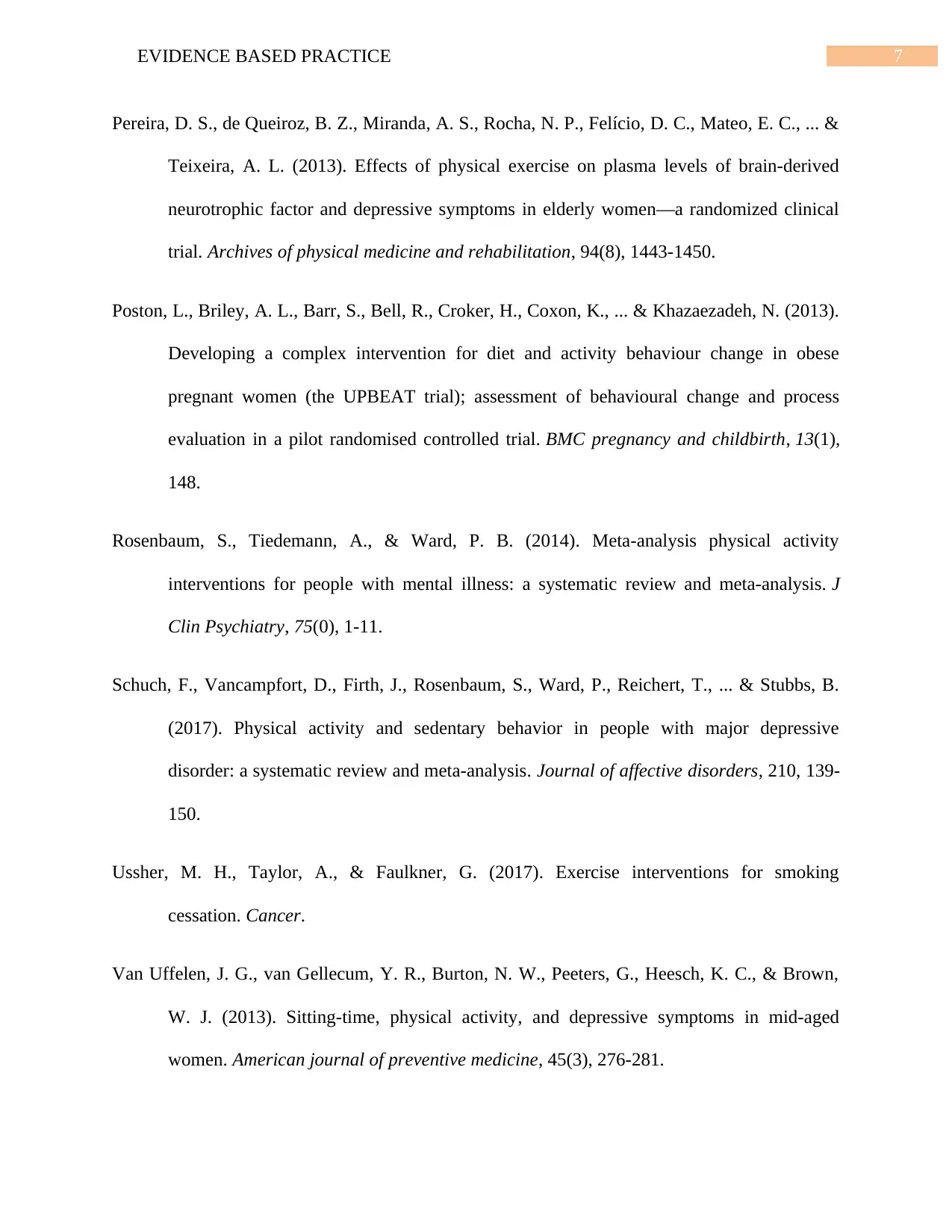
7EVIDENCE BASED PRACTICE
Pereira, D. S., de Queiroz, B. Z., Miranda, A. S., Rocha, N. P., Felício, D. C., Mateo, E. C., ... &
Teixeira, A. L. (2013). Effects of physical exercise on plasma levels of brain-derived
neurotrophic factor and depressive symptoms in elderly women—a randomized clinical
trial. Archives of physical medicine and rehabilitation, 94(8), 1443-1450.
Poston, L., Briley, A. L., Barr, S., Bell, R., Croker, H., Coxon, K., ... & Khazaezadeh, N. (2013).
Developing a complex intervention for diet and activity behaviour change in obese
pregnant women (the UPBEAT trial); assessment of behavioural change and process
evaluation in a pilot randomised controlled trial. BMC pregnancy and childbirth, 13(1),
148.
Rosenbaum, S., Tiedemann, A., & Ward, P. B. (2014). Meta-analysis physical activity
interventions for people with mental illness: a systematic review and meta-analysis. J
Clin Psychiatry, 75(0), 1-11.
Schuch, F., Vancampfort, D., Firth, J., Rosenbaum, S., Ward, P., Reichert, T., ... & Stubbs, B.
(2017). Physical activity and sedentary behavior in people with major depressive
disorder: a systematic review and meta-analysis. Journal of affective disorders, 210, 139-
150.
Ussher, M. H., Taylor, A., & Faulkner, G. (2017). Exercise interventions for smoking
cessation. Cancer.
Van Uffelen, J. G., van Gellecum, Y. R., Burton, N. W., Peeters, G., Heesch, K. C., & Brown,
W. J. (2013). Sitting-time, physical activity, and depressive symptoms in mid-aged
women. American journal of preventive medicine, 45(3), 276-281.
Pereira, D. S., de Queiroz, B. Z., Miranda, A. S., Rocha, N. P., Felício, D. C., Mateo, E. C., ... &
Teixeira, A. L. (2013). Effects of physical exercise on plasma levels of brain-derived
neurotrophic factor and depressive symptoms in elderly women—a randomized clinical
trial. Archives of physical medicine and rehabilitation, 94(8), 1443-1450.
Poston, L., Briley, A. L., Barr, S., Bell, R., Croker, H., Coxon, K., ... & Khazaezadeh, N. (2013).
Developing a complex intervention for diet and activity behaviour change in obese
pregnant women (the UPBEAT trial); assessment of behavioural change and process
evaluation in a pilot randomised controlled trial. BMC pregnancy and childbirth, 13(1),
148.
Rosenbaum, S., Tiedemann, A., & Ward, P. B. (2014). Meta-analysis physical activity
interventions for people with mental illness: a systematic review and meta-analysis. J
Clin Psychiatry, 75(0), 1-11.
Schuch, F., Vancampfort, D., Firth, J., Rosenbaum, S., Ward, P., Reichert, T., ... & Stubbs, B.
(2017). Physical activity and sedentary behavior in people with major depressive
disorder: a systematic review and meta-analysis. Journal of affective disorders, 210, 139-
150.
Ussher, M. H., Taylor, A., & Faulkner, G. (2017). Exercise interventions for smoking
cessation. Cancer.
Van Uffelen, J. G., van Gellecum, Y. R., Burton, N. W., Peeters, G., Heesch, K. C., & Brown,
W. J. (2013). Sitting-time, physical activity, and depressive symptoms in mid-aged
women. American journal of preventive medicine, 45(3), 276-281.
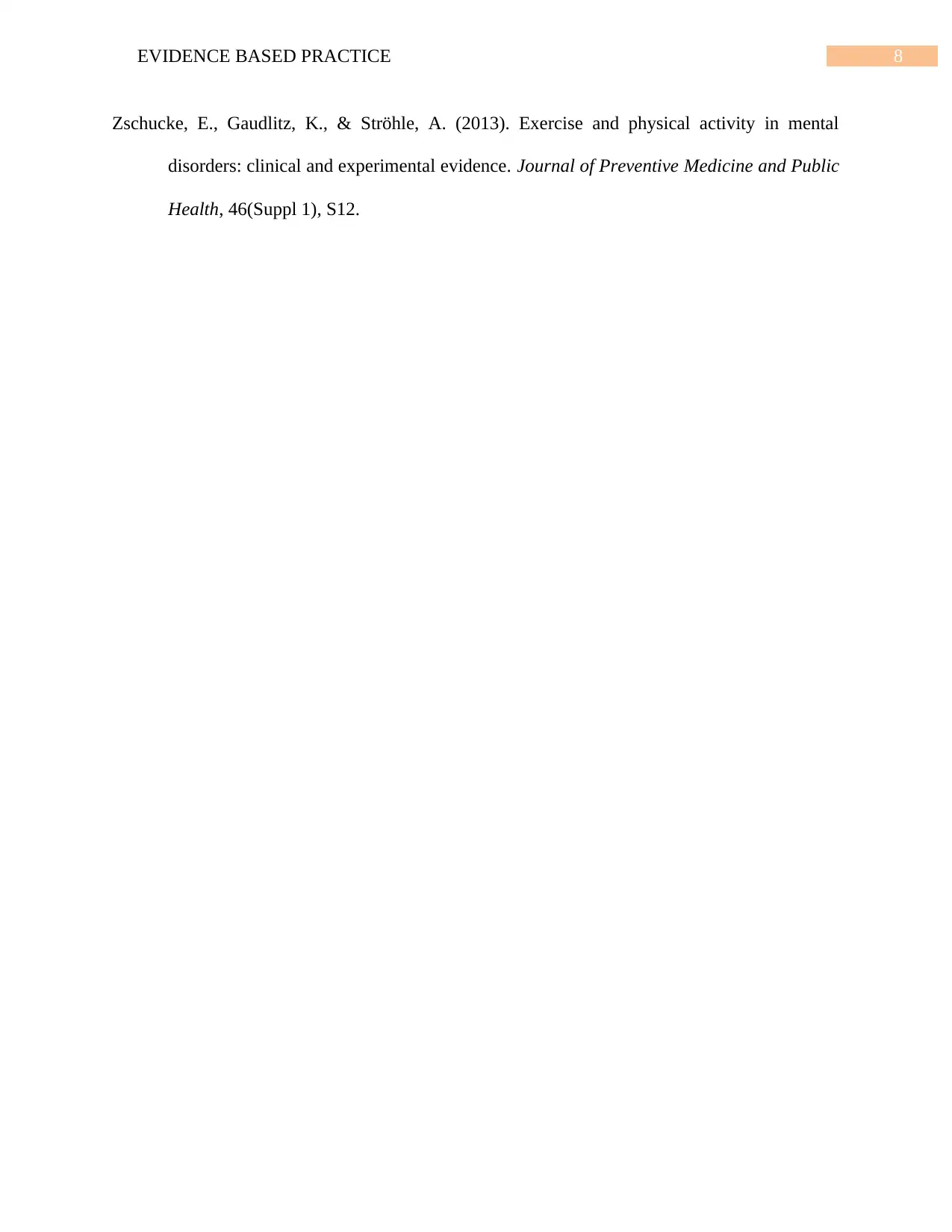
8EVIDENCE BASED PRACTICE
Zschucke, E., Gaudlitz, K., & Ströhle, A. (2013). Exercise and physical activity in mental
disorders: clinical and experimental evidence. Journal of Preventive Medicine and Public
Health, 46(Suppl 1), S12.
Zschucke, E., Gaudlitz, K., & Ströhle, A. (2013). Exercise and physical activity in mental
disorders: clinical and experimental evidence. Journal of Preventive Medicine and Public
Health, 46(Suppl 1), S12.
⊘ This is a preview!⊘
Do you want full access?
Subscribe today to unlock all pages.

Trusted by 1+ million students worldwide
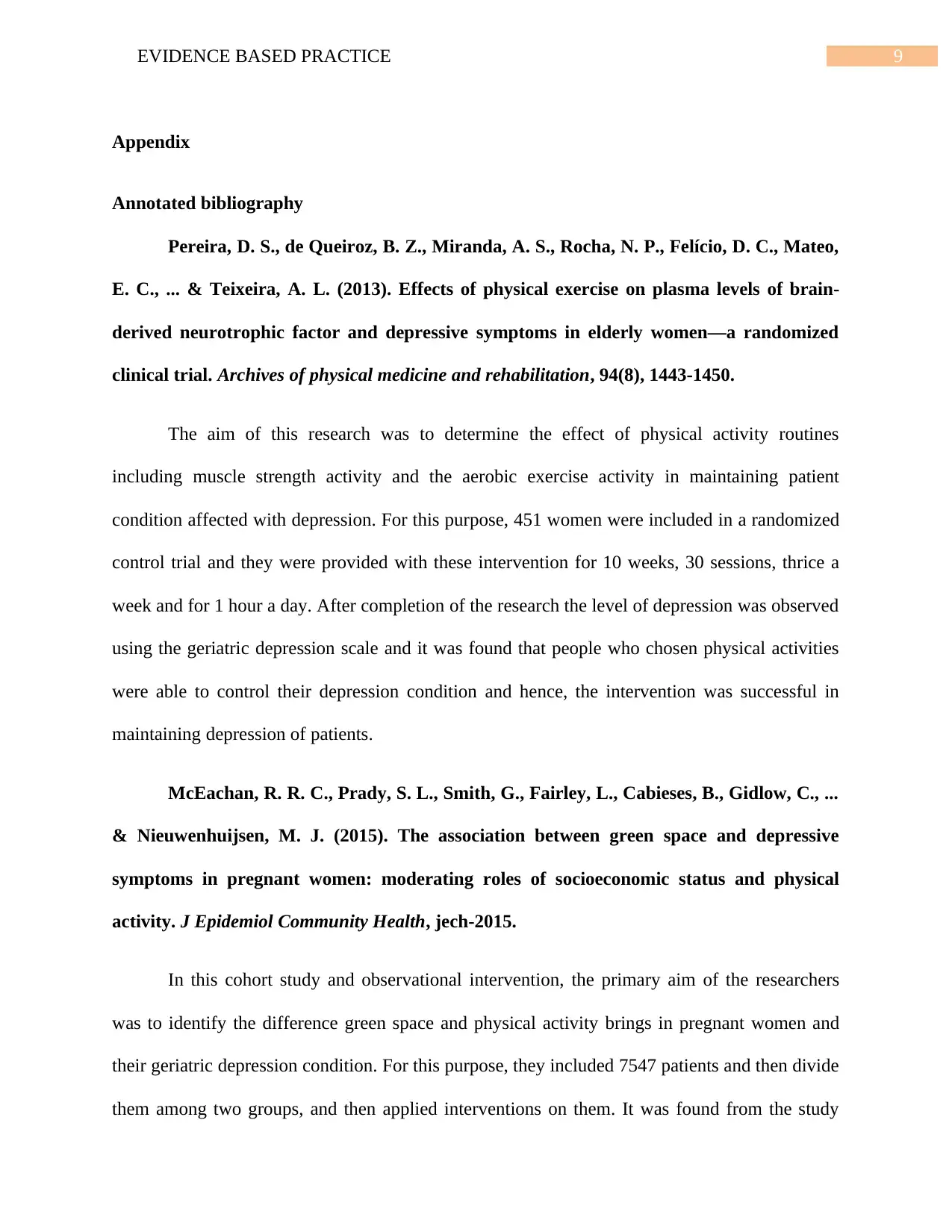
9EVIDENCE BASED PRACTICE
Appendix
Annotated bibliography
Pereira, D. S., de Queiroz, B. Z., Miranda, A. S., Rocha, N. P., Felício, D. C., Mateo,
E. C., ... & Teixeira, A. L. (2013). Effects of physical exercise on plasma levels of brain-
derived neurotrophic factor and depressive symptoms in elderly women—a randomized
clinical trial. Archives of physical medicine and rehabilitation, 94(8), 1443-1450.
The aim of this research was to determine the effect of physical activity routines
including muscle strength activity and the aerobic exercise activity in maintaining patient
condition affected with depression. For this purpose, 451 women were included in a randomized
control trial and they were provided with these intervention for 10 weeks, 30 sessions, thrice a
week and for 1 hour a day. After completion of the research the level of depression was observed
using the geriatric depression scale and it was found that people who chosen physical activities
were able to control their depression condition and hence, the intervention was successful in
maintaining depression of patients.
McEachan, R. R. C., Prady, S. L., Smith, G., Fairley, L., Cabieses, B., Gidlow, C., ...
& Nieuwenhuijsen, M. J. (2015). The association between green space and depressive
symptoms in pregnant women: moderating roles of socioeconomic status and physical
activity. J Epidemiol Community Health, jech-2015.
In this cohort study and observational intervention, the primary aim of the researchers
was to identify the difference green space and physical activity brings in pregnant women and
their geriatric depression condition. For this purpose, they included 7547 patients and then divide
them among two groups, and then applied interventions on them. It was found from the study
Appendix
Annotated bibliography
Pereira, D. S., de Queiroz, B. Z., Miranda, A. S., Rocha, N. P., Felício, D. C., Mateo,
E. C., ... & Teixeira, A. L. (2013). Effects of physical exercise on plasma levels of brain-
derived neurotrophic factor and depressive symptoms in elderly women—a randomized
clinical trial. Archives of physical medicine and rehabilitation, 94(8), 1443-1450.
The aim of this research was to determine the effect of physical activity routines
including muscle strength activity and the aerobic exercise activity in maintaining patient
condition affected with depression. For this purpose, 451 women were included in a randomized
control trial and they were provided with these intervention for 10 weeks, 30 sessions, thrice a
week and for 1 hour a day. After completion of the research the level of depression was observed
using the geriatric depression scale and it was found that people who chosen physical activities
were able to control their depression condition and hence, the intervention was successful in
maintaining depression of patients.
McEachan, R. R. C., Prady, S. L., Smith, G., Fairley, L., Cabieses, B., Gidlow, C., ...
& Nieuwenhuijsen, M. J. (2015). The association between green space and depressive
symptoms in pregnant women: moderating roles of socioeconomic status and physical
activity. J Epidemiol Community Health, jech-2015.
In this cohort study and observational intervention, the primary aim of the researchers
was to identify the difference green space and physical activity brings in pregnant women and
their geriatric depression condition. For this purpose, they included 7547 patients and then divide
them among two groups, and then applied interventions on them. It was found from the study
Paraphrase This Document
Need a fresh take? Get an instant paraphrase of this document with our AI Paraphraser
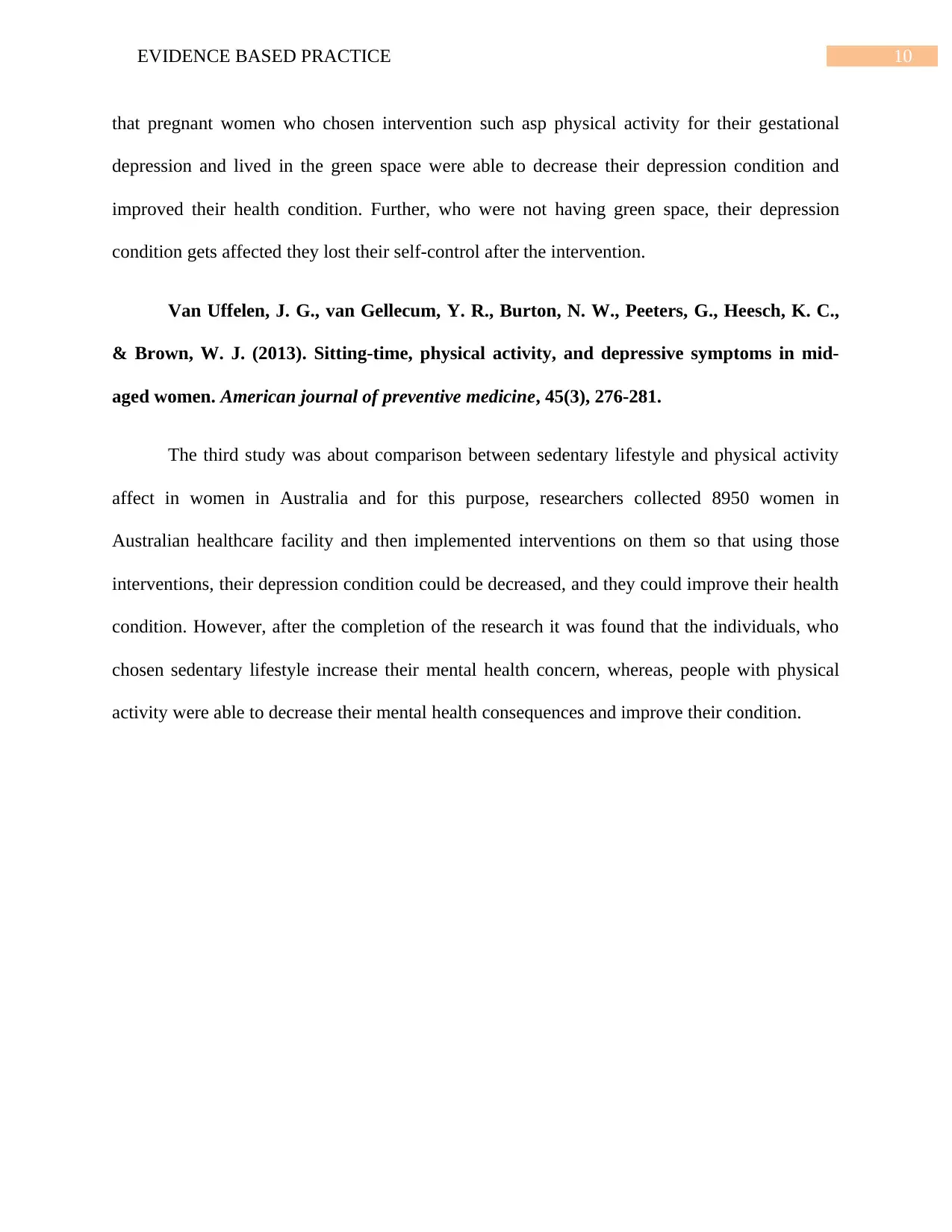
10EVIDENCE BASED PRACTICE
that pregnant women who chosen intervention such asp physical activity for their gestational
depression and lived in the green space were able to decrease their depression condition and
improved their health condition. Further, who were not having green space, their depression
condition gets affected they lost their self-control after the intervention.
Van Uffelen, J. G., van Gellecum, Y. R., Burton, N. W., Peeters, G., Heesch, K. C.,
& Brown, W. J. (2013). Sitting-time, physical activity, and depressive symptoms in mid-
aged women. American journal of preventive medicine, 45(3), 276-281.
The third study was about comparison between sedentary lifestyle and physical activity
affect in women in Australia and for this purpose, researchers collected 8950 women in
Australian healthcare facility and then implemented interventions on them so that using those
interventions, their depression condition could be decreased, and they could improve their health
condition. However, after the completion of the research it was found that the individuals, who
chosen sedentary lifestyle increase their mental health concern, whereas, people with physical
activity were able to decrease their mental health consequences and improve their condition.
that pregnant women who chosen intervention such asp physical activity for their gestational
depression and lived in the green space were able to decrease their depression condition and
improved their health condition. Further, who were not having green space, their depression
condition gets affected they lost their self-control after the intervention.
Van Uffelen, J. G., van Gellecum, Y. R., Burton, N. W., Peeters, G., Heesch, K. C.,
& Brown, W. J. (2013). Sitting-time, physical activity, and depressive symptoms in mid-
aged women. American journal of preventive medicine, 45(3), 276-281.
The third study was about comparison between sedentary lifestyle and physical activity
affect in women in Australia and for this purpose, researchers collected 8950 women in
Australian healthcare facility and then implemented interventions on them so that using those
interventions, their depression condition could be decreased, and they could improve their health
condition. However, after the completion of the research it was found that the individuals, who
chosen sedentary lifestyle increase their mental health concern, whereas, people with physical
activity were able to decrease their mental health consequences and improve their condition.

11EVIDENCE BASED PRACTICE
⊘ This is a preview!⊘
Do you want full access?
Subscribe today to unlock all pages.

Trusted by 1+ million students worldwide
1 out of 12
Related Documents
Your All-in-One AI-Powered Toolkit for Academic Success.
+13062052269
info@desklib.com
Available 24*7 on WhatsApp / Email
![[object Object]](/_next/static/media/star-bottom.7253800d.svg)
Unlock your academic potential
Copyright © 2020–2025 A2Z Services. All Rights Reserved. Developed and managed by ZUCOL.





